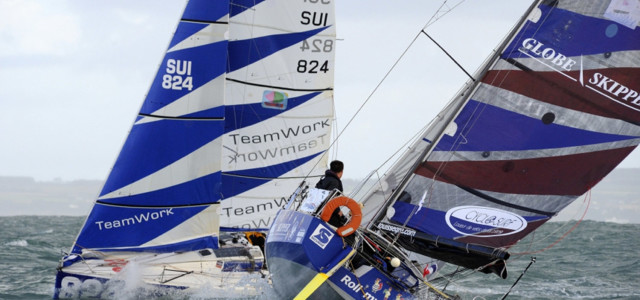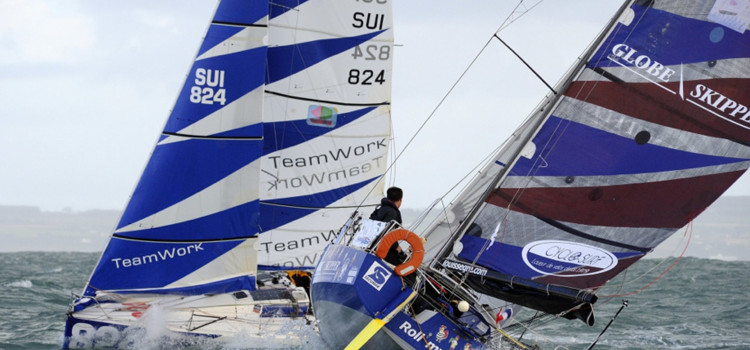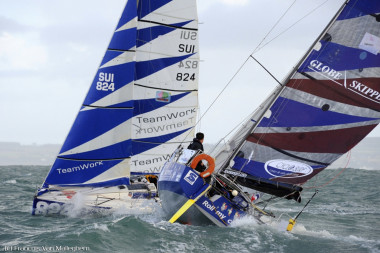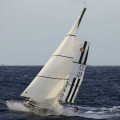


 Sada – Dopo quasi un mese di rinvii, la partenza della Mini Transat 2013 è stata definitivamente fissata per Martedì 12 novembre alle ore 15.00 dal porto di Sada nella Galizia (Spagna).
Sada – Dopo quasi un mese di rinvii, la partenza della Mini Transat 2013 è stata definitivamente fissata per Martedì 12 novembre alle ore 15.00 dal porto di Sada nella Galizia (Spagna).
Partiti da Douarnenez (Bretagna) il 29 ottobre, le ottantaquattro barche iscritte alla regata oceanica in solitario su barche di 6 metri e 50, sono state bloccate dall’organizzazione, a causa del maltempo, nel porto di Sada mancando il primo step di Lanzarote previsto da programma e vedendosi annullare la prima parte della regata.
In questo primo tratto trasformato in un lungo e faticoso trasferimento fino al piccolo porto spagnolo, con venti fino a 42 nodi e mare molto agitato, circa 10 imbarcazioni si sono ritirate per danni subiti durante la tempesta nel Golfo di Biscaglia.
Le finestre meteo che potevano permettere una nuova partenza non si sono presentate fino a qualche giorno fa, costringendo il Comitato ad annullare lo stop previsto alle Canarie e cambiando la regata in un’unica tappa fino alla Guadalupe, dove gli skipper arriveranno in circa 28 giorni di navigazione no stop e percorrendo 3700 miglia. La più lunga delle Mini Transat dal 1977, data della sua prima edizione.
Al via per l’Italia ci saranno Michele Zambelli (Fontanot ITA-342), Giancarlo Pedote (Prysmian), Alberto Bona (OnLineSim), Federico Fornaro (ITA-568), Andrea Iacopini (ITA-682) e Davide Lusso (ITA-600).
![]()
MINI TRANSAT, A LEG? NO, AN EPIC
Sada – 30 days have now elapsed between the theoretical start date from Douarnenez and the new start date from Sada, close to La Coruna, for what will be the longest leg ever sailed in the history of the Mini Transat. It’s been almost a month of tough times and misfortunes before a positive way forward could be found.
On the pontoons of Sada, the competitors are steadily getting into race mode. Computers are operating at full capacity, the latest weather files and the analysis of the best experts are tracked, compared, disected … only a few competitors remain at sea, the last have left the port of Moras, where Jean-Pierre Dick took refuge during the Vendée Globe before crossing the Bay of Biscay, and they should arrive tonight.
Windows are slammed and the race abandoned
Right now, everyone is in a hurry to the long wait to be over. They first had to wait in Douarnenez pending an unlikely weather window. A wait that was all the more infuriating because the two weeks of preparation for the Mini Transat took place in idyllic weather conditions. Two days earlier and the fleet would have comfortably been passing Cape Finisterre and then hurtling on Lanzarote. This is something that the organisers will be exploring for the next edition, to be able to adjust a possible start by bringing it forward a few days if weather conditions require. In Douarnenez, the Race Director was watching for the best time to release the fleet. Every time a window seemed to open the next set of files contradicted the hope of finding the right moment.
Finally on October 29 the race could get underway in a west to northwesterly wind of 25 knots whicheased during the first night. It was during this same night that the Race Director noted a further deterioration of the forecast and decided, as anticipated in the latest changes to the Sailing Instructions, to divert the fleet to Sada, after a first half leg. Unfortunately, the bad weather arrived faster than expected, and it was ultimately decided to stop the race and advise those competitors still a long way from the port of Sada to proceed to Gijon, where weather conditions were better.
A tough delivery convoy
In the great Asturian harbor everyone was once again waiting, this time to join up with the first competitors who had sought refuge in Sada. Despite the small number of boats in Sada, it was most logical that the entire fleet would rally at the Galician port: to have required the competitors at Sada to sail east to Gijon, would have been a kind of double jeopardy. Added to the frustration of not being able to receive a finishing position, would have been a useless delivery considering that the ultimate goal was to achieve the shortest route possible to pass Cape Finisterre. For the competitors sheltering in Gijon, it was now necessary to find a way to leave in convoy. The return to the west was not to be a sinecure: the passages around l’Estaca de Barres and Cape Ortegal was in angry seas and winds gusting up to 40 knots at times. Many competitors admitted that it was the first time they faced such difficult conditions.
Now all of our little family, or almost, are gathered at or near Sada to make the first start of this Mini Transat Douarnenez – Pointe a Pitre. From Monday the winds will shift to the north. The fleet will finally know the intoxication of surfing off-wind. After the hard graft comes the reward.
What they said:
Sofie de Clercq (Ville de Marseillan): “During my delivery, I had an autopilot problem. To get some rest I decided to heave to several times. But at no time did I think to stop. In any case, I’m really glad I did that. The scenery was really beautiful and I discovered something that I never would have known otherwise. In Minis, 35 knots is acceptable, but 40 knots, it’s just too…“.
Hugues Chollet (Soutenez le Bel Espoir): “I never thought I’d be able to do what I did. When we left Gijon, we were not making headway, we couldn’t make decent progress. Like many others, I stopped at Moras. At this time, I was at the bottom of a hole, really depressed. With some other competitors we found ourselves on one of the accompanying support boats where they gave us a good meal. The next day, morale had returned, it was almost beautiful. We knew there would be wind, but I told myself, this is a challenge, you have to go. We took a good bashing, but we made it. Looking back, I am proud to have managed it“.




No comments so far.
Be first to leave comment below.